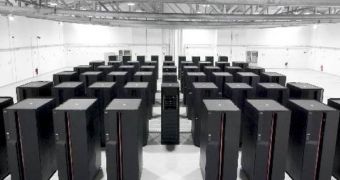The US Department of Energy (DOE) will start making thousands of processor hours available to open, unclassified research, at two new supercomputer facilities, starting from 2010. The two machines that will accept independent studies will be Oak Ridge National Laboratory's (ORNL) Cray XT system “Jaguar,” in Tennessee, and the Argonne National Laboratory's IBM Blue Gene/P “Intrepid,” in Illinois.
These machines are two of the most powerful in the world, and, unlike many other DOE facilities, are not dedicated to classified research. They will be used for a number of applications, including creating models for new galaxies, in hopes of identifying the elusive dark matter, designing new simulations to understand climate change, and even constructing virtual plasma reactors, to test ideas related to nuclear fusion.
For the entire year of 2009, some 900 million processing hours are up for grabs. One million processing hours is the time covered by 1,000 processors working for 1,000 hours, or around 41 days. But the Jaguar got a rather massive processor boost, and now contains 180,832 units, as opposed to the 31,328 it had last year. On the other hand, Intrepid has also received an enormous upgrade, and now counts 163,840 processors, a large increase from the 32,768 it had a year ago. With the improvements, Jaguar has become the second largest and powerful supercomputer in the world, after IBM's Roadrunner. It operates at about 1.46 petaflops, or a quadrillion and a half floating point operations per second.
DOE spokesman Jeff Sherwood said that, “This is an incredible increase in computing power, which was itself a huge increase from the year before. It’s for research that would not be possible without petascale computing.” This means that experts who will benefit from processor hours on these computers will now have the opportunity to test extremely complex simulations, in which they will be able to control and fine-tune a large number of factors. This could lead to the most comprehensive and detailed finds in recent history, in areas ranging from space studies to medicine and the environment.
“These are the only places in the world where you can do these types of simulations. In the case of stars and dark matter, there’s a lot of physics going on. They’re very attractive targets for a big machine like this,” ORNL expert Bronsom Messer, whose team now benefits from 75 million processing hours for this year, explained. Their study of core-collapse supernovae has received more computing hours than any other project that applied for space on one of the two machines.
“People have been trying to attack this on computers for 40 to 50 years. We’re using simulations to basically pick a neutrino and ride along as it flies out of the star, and do this with as many neutrinos as possible. We’re finally starting to see some hints of what’s happening, and we’re pretty jazzed about it,” the expert concluded.

 14 DAY TRIAL //
14 DAY TRIAL //